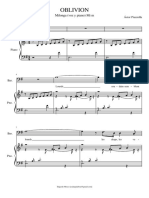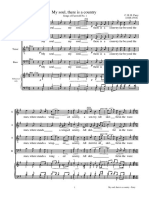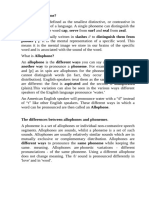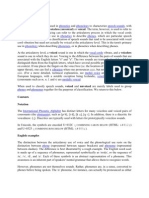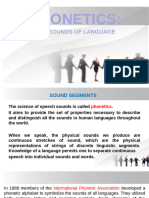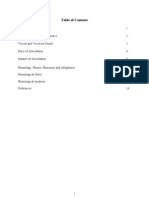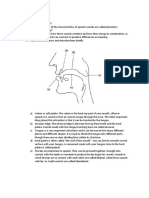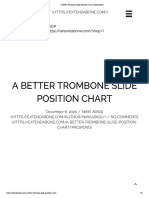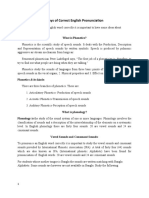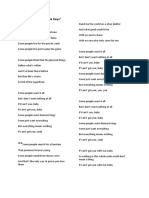ENG507 (MIDS) Solved
ENG507 (MIDS) Solved
Uploaded by
malik.imaanCopyright:
Available Formats
ENG507 (MIDS) Solved
ENG507 (MIDS) Solved
Uploaded by
malik.imaanOriginal Title
Copyright
Available Formats
Share this document
Did you find this document useful?
Is this content inappropriate?
Copyright:
Available Formats
ENG507 (MIDS) Solved
ENG507 (MIDS) Solved
Uploaded by
malik.imaanCopyright:
Available Formats
ENG507 (MIDS) Fall2019
Q. Subtypes of phonology (3)
Q. When the focal folds are tight together the resultant sounds are called Voiced.
Q. the sponge like tissues contained within air range is called the diaphragm.
Q. Another name of phonemic transcription is (Broad Transcription)
Q. the length of the VOT is dependent on the practical measurement is based on the practical measure of
aspiration
Q. In auditory phonetics we study sound with
Q. In English there are (24) consonants
Q. Voiceless stops at syllable initial are ASPIRATED
Q. Consonants at the end of syllable are LONGER
Q. Voiced stops at syllable initial are VOICELESS.
Q. Right Transcription of furiously... Choose from options ˈfjɝː.i-
Q. Voiceless stops are ASPIRATED in onset position
Q. Unaspirated voiceless stop has Voice onset time near ZERO
Q. all sound produced..... Help of air compressed by LUNGS
Q. Frequency, pitch, and loudness are PHYSICAL features.
Q. another name for phonemic transcription is .
a) Narrow transcription b) broad transcription C) orthographic transcription d) technical transcription
Q. Which of the following branches of phonetic focuses on methodologies and aspect of experimental work
on------ speech sounds? Experimental phonetics
Q. in English there are ---- consonant types
2 3 5 7
Q. the short symbols which are used for indicating suprasegmental------- diacritics [ʲ]
Q. noticeable event accruing at regular intervals
a. Tone b. pitch c. rhythm d. intonation
Q. In order to describe intonation, we need to analyze the role of a ‘stressed syllable’
Maha Malik’s Compilation Page 1
ENG507 (MIDS) Fall2019
Q. /3/ and /a/ are examples of vowel
a.lax b.Tense c.lenis d.forties
Q. How many sub types does phonology has
2 3 4
Q. Phonology is the study of........ Structure of language
Sound Grammar
Q. lenis refers to a sound made with a relatively.......... Muscular effort.
Less quick Strong Weak
Q. the velaric airstream mechanism involves an air flame produced by a movement of the back of tongue
against the
Hard palat Soft palat
Q. Higher overtone F2 tells about the position of TONGUE.
Q. In IPA small symbols superimposed on segments are called DIACRITICS
Q. Lax sounds are produced with LESS muscular effort.
Q. Optimality theory has stemmed from GENERATIVE phonology.
Q. Human speech production is studied under the branch of phonetics.
Q. While studying vowels on spectrogram overtone F2 tells us about the position of ___
Q. phonemic transcription is enclosed in slashes or oblique lines
Q. fricatives are also known as spirants
Q. A phoneme is the smallest meaningful unit of sound
Q. In typical tone languages linguistic function of phoneme is to change meaning of word.
Q. /b/ /d/ fall under the category of___
voiced voiceless
Q. Which word used in long vowels barn
Q. When a sound is not primarily articulated and some other sound is added to it known as. Articulation
Q. Intonation refers (very) simply to the variations in the pitch of a speaker’s voice (f0).
Q. In order to describe intonation, we need to analyze the role of a ‘stressed syllable’.
Q. This term is used to describe some varieties of English (e.g., American) pronunciation in which the /r/
phoneme is found in all its phonological contexts.
Maha Malik’s Compilation Page 2
ENG507 (MIDS) Fall2019
Q. The term ‘stop’ is used in the phonetic classification of consonant sounds on the basis of their manner of
articulation.
Q. The North wind and the sun is a folktale taken from (Arne Thompson)
Q. /€:/ and /a:/ are the examples of ... (Tense)
Q. The glottis is defined as the space (vocal folds)
Q. In English /p t k/ at the beginning of a syllable are aspirated
Q. Define the term 'rhotic accent'
A rhotic speaker pronounces the letter "R" in hard and water. In other words, rhotic speakers pronounce "R" in all
positions.
Q. Two types of sounds involving aspiration process - 2 marks
Phonetically, aspiration is the result of the vocal cords being widely parted at the time of the articulatory release. Is
some languages (such as English) aspiration is allophonic while in others (such as Urdu) it is phonemic.
Q. Tone language's
In the case of tone languages, it is usual to identify tones as being a property of individual syllables, whereas an
intonational tone may be spread over many syllables. Similarly, in the analysis of English intonation, tone refers to
one of the pitch possibilities for the tonic (or nuclear) syllable, a set usually including fall, rise, fall–rise and rise–
fall, though others are also suggested by various experts.
Q. feel, father, put describe vowels with tongue position
A low vowel (such as a in “father” or “had”) is produced with the tongue relatively flat. You may also be able to
feel the [i] as somewhat further forward
Q. pronouncing /u/ tongue position is:
Vowel /ʊ/ is often pronounced with spread lips in this variety of English. It is like the back of the tongue is raised
for an /u/ vowel sound creating a secondary (articulation) constriction.
Q. H and L stand for in break indicates 2 marks
One of the most recently developed methods is called the ‘tone and break indices’ (ToBI). This method is used for
the description of intonation (H/L) representing pitch changes and showing pitch accent – phrase accent and
boundary by showing tone and break indices. This is based on describing High (H) and Low (L) pitches in a
sentence representing pitch changes and showing pitch accent – phrase accent and boundary (of the phrase).
Q. Define relation of F1 and F2 in vowel sound?
Maha Malik’s Compilation Page 3
ENG507 (MIDS) Fall2019
Acoustically, vowels are mainly distinguished by the first two formant frequencies F1 and F2; F1 is inversely related
to the vowel height (which means that smaller F1 amplitude = higher vowels), and F2 is related to the front or back
of the vowels (smaller F2 amplitude = more back vowels).
Q. What does Grey areas indicate in chart
Areas of darker gray represent impossible articulations.
Q. Define sibilant fricative
The fricatives [s, z, ʒ, ʃ] are called sibilant sounds. Sibilant fricatives (such as s, ʃ) are strong and clearly audible
and strident fricatives are weak and less audible (such as θ, f).
Q. No. Of syllables of exist.,pronunciation and enough 3 marks
1. Ex-ist
2. Pro-nun-ci-a-tion
3. En-ough
Q. EXPLAIN the features (Voicing, MoA and PoA)
Place of articulation = alveolar. The narrowing of the vocal tract involves the tongue tip &the alveolar
ridge
Manner of articulation = oral stop. (The narrowing is complete -- the tongue is completely blocking off
airflow through the mouth. ...
Voicing = voiced. articulation, phonation, etc.
Q. Stress Rules: (V.V.V. IMP)
2 types of stress are important. Firstly, stress on a syllable within a word (the lexical stress) which changes the
grammatical category of a word (compare insult with insult) and also change meaning among other things. On the
other hand, stress on a word or certain words in a phrase or sentence. This type of stress (on word(s) within
sentences) is called sentence level or prosodic stress. This is, in fact, a change or modification to word level stress in
a sentence which is basically a change of ‘beat’ on certain words in a sentence. Remember that, we create ‘rhythm’
in spoken language on the basis of stress.
Q. Homograph
It is a group (usually a pair) of words that are spelled the same way, & may or may not be pronounced the same
way, although the difference in pronunciation is often just a shift in the accented syllable. There is a whole class of
homographs that end in -ate, usually with one being a verb and the other being a noun or an adjective related to it.
E.g : "Advocate" can be pronounced with a long "a" sound and mean "to speak or write in support of" "Advocate"
can also be pronounced with a short "a" sound and refer to a person who supports or pleads the cause of another.
Q. Supra segmental
Maha Malik’s Compilation Page 4
ENG507 (MIDS) Fall2019
‘Supra’ means above (beyond) and ‘segments’ means sounds (such as vowels and consonants) so the term
‘suprasegmental’ means ‘above sounds’. The term suprasegmental was initially invented to refer to aspects of sound
such as intonation that did not seem to be the properties of individual segments (i.e. the vowels and consonants of
which speech is composed).. There has never been full agreement about how many suprasegmental features are to be
found in speech, but pitch, loudness, tempo, juncture, syllable, rhythm and stress are the most commonly mentioned
ones.
Q. Phonation types:
Voiceless – when the folds are open apart and the air passing through the glottis freely (/t/ or /p/).
Voiced – when the folds are tight together and there is vibration during the air passage though the
glottis (e.g., /b/ or /d/).
Creaky voice – when there is a slight opening in the front and the arytenoid cartilages are tight
together, so that the vocal folds can vibrate only at the anterior end (the small opening at the top).
Breathy or murmuring sound – when the vocal folds are apart but still they are vibrating - a
breathy voice is like a whisper except voice.
Q. Write a brief note on Fortis and Lenis Consonants.
In linguistics, fortis and lenis, also called tense and lax, refer to consonants pronounced with greater and lesser
energy. English has fortis consonants, such as the p in pat, with a corresponding lenis consonant, such as the b in
bat. Fortis and lenis consonants may be distinguished by tenseness or other characteristics, such as voicing,
aspiration, glottalization, velarization, length, and length of nearby vowels. Fortis and lenis were coined for
languages where the contrast between sounds such as p and b does not involve voicing. Fortis and Lenis Consonants
These are the terms used in the phonetic classification of consonantal sounds on the basis of their manners of
articulation. Fortis refers to a sound made with a relatively strong degree of muscular effort and breath force
compared with the other sound (known as lenis). The distinction between tense and lax is used for vowels on the
similar lines.
Q. Velaric air stream mechanism
In addition to pulmonic and glottalic airstream mechanisms, there is a third possibility involving velum. Under this
mechanism, speech sounds are made by sucking the air (see airstream). This sucking mechanism is used first by
babies for feeding and by adult humans in later stages of life for such things as sucking liquid through a straw or
drawing smoke from a cigarette (using the back of the tongue against the velum). The basic mechanism for this is
the air-tight closure between the back of the tongue and the soft palate, just as if the tongue is then retracted, and the
pressure in the oral cavity is lowered and suction takes place. Consonants produced with this mechanism are called
clicks. These sounds have a distinctive role in some languages such as Zulu. In English, they may be heard in the
‘tut tut’ (or tsk tsk) sounds, and in a few other contexts.
Q. What are click sounds?
The basic mechanism for this is the air-tight closure between the back of the tongue and the soft palate, just as if the
tongue is then retracted, and the pressure in the oral cavity is lowered and suction takes place. Consonants produced
with this mechanism are called clicks. These sounds have a distinctive role in some languages such as Zulu. In
English, they may be heard in the ‘tut tut’ (or tsk tsk) sounds, and in a few other contexts
Q. What is Ingressive stream?
Pulmonic airstream mechanism is the most commonly used mechanism for speech production by human beings.
Almost all the sounds we produce in speaking are created with the help of air compressed by the lungs. The
Maha Malik’s Compilation Page 5
ENG507 (MIDS) Fall2019
adjective used for this lung-created airstream is ‘pulmonic’: the pulmonic airstream may be ingressive (as in
breathing in) but for speaking practically, it is always egressive (speech sounds are produced while pushing the air
out). In order to understand this mechanism, we’ll have to analyze the human respiratory system. Under this system,
the respiratory muscles set the air in motion. Lungs – the sponge like tissues – contained within air cage called the
diaphragm – contract and enlarge lung cavity thus creating the egressive – ingressive actions. This mechanism set an
air flow for speech production and human beings produce speech sounds while pushing the air out.
Q. Affricates
An affricate sound is a type of consonant which is made of a plosive followed by a fricative with the same place of
articulation (so, it is a mixture of two steps or gestures). For example, /tʃ/ (the voiceless affricate)has /t/ and /ʃ/ as a
sound at the beginning and end of the English words church /tʃɜ:tʃ/.
Q. phoneme
A phoneme is the smallest meaningful unit of sound (therefore, a smallest unit in phonology) in a language and this
meaningful unit of sound is one that will change one word into another word. For example, the difference in both
‘white’ and ‘right’ (ignore spellings here, focus on sounds) is the difference of sounds (w – r) which are phonemes
and they have the ability to change meaning
Q. lexical stress
Lexical stress is basically related to the primary stress applied at syllable level (when only one syllable is stressed)
that has the ability to change the meaning and the grammatical category of a word as in the case of ‘IMport’ (noun)
and ‘imPORT’ (verb).
Q. salient features of phonetic transcription any 3
In a phonetic transcription the transcriber may use the full range of phonetic symbols if these are required; a narrow
phonetic transcription is one which carries a lot of fine detail about the precise phonetic quality of sounds, while a
broad phonetic transcription gives a more limited amount of phonetic information. Transcription is an important part
of the present course based on the objective to understand the sound-symbol correspondence. Transcription is a
useful technique for highlighting the phonemes of a language during documentation and description.
Q. Rhythm
Sentence rhythm is another feature of a connected speech. Actually, speech is perceived as a sequence of events in
time, and the word rhythm is used to refer to the way events are distributed in time. Obvious example of vocal
rhythms is chanting as part of games (for example, children calling words while skipping or cricket crowds calling
their favorite team’s name). In conversational speech, the sentence rhythm is a bit complicated, but it is clear that the
timing of speech is not random. An extreme view (though a quite common one) is that English speech has a rhythm
that allows us to divide it up into more or less equal intervals of time called feet, each of which begins with a
stressed syllable: this is called the stress-timed rhythm hypothesis (and languages are divided on the basis of this
phenomenon into stress-timed and syllable-timed languages).
Q. Acoustic phonetics.
Acoustic phonetics is related to the study of physical attributes of sounds produced by the vocal tract. It is the branch
of phonetics which studies the physical properties of speech sound as transmitted between mouth and ear according
to the principles of acoustics (the branch of physics devoted to the study of sound).
Q. define diphthongs
Maha Malik’s Compilation Page 6
ENG507 (MIDS) Fall2019
Diphthong is a single vowel consisting of the features of two vowels. Its most important feature is the glide from one
vowel quality to another one (so basically it is a glide). The BBC accent of English contains a large number (eight in
total) of diphthongs including three ending at /ɪ/ (eɪ, aɪ, ɔɪ – as in words bay, buy and boy), two ending at /υ/ (əʊ, aʊ
– as in words no and now) and three ending at /ə/ (ɪə, eə, ʊə - as in words peer, pair and poor ).
Q. name three branches of phonetics
It has three major branches:
1. articulatory phonetics,
2. acoustics phonetics and
3. auditory phonetics.
Q. phonetic aspiration
Aspiration is a puff of noise made when a consonantal constriction is released and air is allowed to escape relatively
freely (e.g., in English /p t k/ at the beginning of a syllable are aspirated). Phonetically, aspiration is the result of the
vocal cords being widely parted at the time of the articulatory release. Is some languages (such as English)
aspiration is allophonic while in others (such as Urdu) it is phonemic. Pronunciation teachers used to make learners
of English practice aspirated plosives by seeing if they could blow out a candle flame with the rush of air after p t k
– this can, of course, lead to a rather exaggerated pronunciation (and superficial burns). A rather different
articulation is used for the so-called voiced aspirated plosives found in many Indian languages (often spelt as ‘bh’,
‘dh’, ‘gh’) where after the release of the constriction the vocal folds vibrate to produce voicing, but are not firmly
pressed together; the result is that a large amount of air escapes at the same time, producing a “breathy” quality. It is
not necessarily only stops that are aspirated as both unaspirated and aspirated affricates also exist in Urdu.
Q. importance of transcription
Transcription is an important tool in phonetics and phonology. Based on a specific set of symbols, transcription is
the writing down of a spoken utterance. In its original meaning, the implied word is converted from one
representation (e.g. written text) into another (e.g. phonetic symbols). Transcription exercises are a long-established
exercise for teaching phonetics. There are many different types of transcription: the most fundamental division that
can be made is between phonemic (broad) and phonetic (narrow) transcription. In the case of the former, the only
symbols that may be used are those which represent one of the phonemes of the language, and extra symbols are
excluded. In a phonetic transcription the transcriber may use the full range of phonetic symbols if these are required;
a narrow phonetic transcription is one which carries a lot of fine detail about the precise phonetic quality of sounds,
while a broad phonetic transcription gives a more limited amount of phonetic information. Transcription is an
important part of the present course based on the objective to understand the sound symbol correspondence.
Transcription is a useful technique for highlighting the phonemes of a language during documentation and
description.
Q. discuss phonetics and phonology in linguistics
Maha Malik’s Compilation Page 7
ENG507 (MIDS) Fall2019
Q. what is negative VOT or Difference b/w negative and positive VOT OR What is Positive VOT or three
possible types of VOTbased on the nature of stop sounds
1. Firstly, simple unaspirated voiceless stops have a voice onset time at or near zero. This means that the
voicing of a following vowel begins at or near to when the stop is released.
2. The second possibility is when aspirated stops are followed by a vowel: voice onset time is greater than
zero called a positive VOT. The length of the VOT in such cases is based on the practical measure of
aspiration – the longer the VOT, the stronger the aspiration lasts twice as long as that of English - 150ms).
3. The third possibility is when voiced stops have a VOT noticeably less than zero called "negative VOT".
This would simply mean that the vocal cords start vibrating before the stop is released.
Q. Difference between American n BBC accents
Accent difference must be realized while transcribing for a specific accent (e.g., British vs. US accent) as one
language can have many possible transcriptions. So, in order to realize the differences based on a typical accent, we
need to know four types of variations among various accents of a language:
a. Difference in phonological inventories. Compare /strʌt/ vs. /strʊt/.
b. Difference in phonetic features such as pronouncing /t/ as [ʔ].
c. Phonological distribution e.g., rhotic vs. non-rhotic accents.
d. Lexical distribution e.g., /θ/ and /ð/ differences (as England and Wales have /ð/ and
Scottish accents have /θ/).
Q. Narrow transcription
In narrow transcription, the sounds are symbolized on the basis of their articulatory/auditory identity, regardless of
their function in a language (sometimes called an impressionistic transcription). In a phonetic transcription, the aim
Maha Malik’s Compilation Page 8
ENG507 (MIDS) Fall2019
is not to judge the functional significance of sounds, in the context of some languages, but to identify the sounds as
such (phonetic variation).
Q. Airstream mechanism
‘Airstream’ is a term used in phonetics for a physiological process which provides a source of energy capable of
being used in speech sound production. There are various forms and mechanisms for initiating the air move. The
most common is when the air is moved inwards or outwards by initiating air movement involving ‘lungs’ (the
pulmonic airstream), which is used for producing the majority of human speech sounds. The ‘glottalic’ airstream
mechanism, as its name suggests, uses the movement of the glottis - the aperture between the vocal folds as the
source of energy. The third one is the ‘velaric’ airstream mechanism which involves an airflow produced by a
movement of the back of the tongue against the velum.
Q. Velarization
In co-articulation, velarisation is a process whereby a constriction in the vocal tract is added to the primary
constriction which gives a consonant its place of articulation. More specifically, velarisation is an example of
secondary articulation. In the case of English “dark /l/”, the /l/ phoneme is produced with its usual primary
constriction in the alveolar region (try speaking this sound). It is like the back of the tongue is raised for an /u/ vowel
sound creating a secondary (articulation) constriction. There are more examples, life vs. file (/laɪf/ /faɪl̴/) clap vs. talc
(/klæp/ /tæl̴k/). It is a very common feature of Arabic and is quite important and interesting for acoustic analysis.
Q. VOT
Voice Onset Time (VOT) is a term used in phonetics referring to the point in time at which vocalfold vibration starts
in relation to the release of a closure (during the production of plosive sounds). In order to understand VOT, the
three types of plosive sounds are to be explained – voiced, voiceless and a voiceless aspirated sound. For example,
during the production of a fully voiced plosive (e.g., /b/ or /g/), the vocal folds vibrate throughout; in a voiceless
unaspirated plosive (such as /p/ or /t/), there is a delay (or lag) before voicing starts; and, in a voiceless aspirated
plosive (e.g., /pʰ/ or /tʰ/), the delay is much longer, depending on the amount of aspiration. The amount of this delay
is called Voice Onset Time (VOT) which in relation to the types of plosive varies from language to language.
Q. Types of stops
1. Voiceless stops (e.g., p, t, k) are aspirated when they are syllable initial (pip, test, kick).
2. Voiced stops (b, d, g) and affricate (dʒ) are voiceless when they are syllable initial (except when
immediately preceded by a voiced sound – compare a day with this day).
3. Voiceless stops (p, t, k) are unaspirated after /s/ in words such as spew, stew and skew
Q. Pitch and variables
The three variables of pitch
1. range,
2. height and
3. Direction.
Q. Nasalization.
Nasalization is an articulatory process whereby a sound is made ‘nasal’ (when the air is passing through the nasal
cavity) due its adjacent nasal sound (it is an articulatory influence of an adjacent nasal consonant, as in words like
Maha Malik’s Compilation Page 9
ENG507 (MIDS) Fall2019
mat or hand). A vowel can also be nasalised in words like man (when /a/ may be articulated with the soft palate
lowered throughout), because of the nasal consonants’ influence (this is called anticipatory coarticulation).
Q. function of intonation
In many languages, including English, intonation serves a grammatical function, distinguishing one type of phrase
or sentence from another. Thus, “Your name is John,” beginning with a medium pitch and ending with a lower one
(falling intonation), is a simple assertion; “Your name is John?”, with a rising intonation (high final pitch), indicates
a question.
Q. define stop consonant
‘Stop’ is often used as if synonymous with plosive. However, some phoneticians use it to refer to the class of sounds
in which there is complete closure specifically in the oral cavity. In this case, sounds such as m, n are also stops.
More precisely, they are nasal stops. In English, there are nine stops (six oral and three nasal):
bilabial alveolar velar
- Voiced p t k
+Voiced b d g
(nasal) +Voiced m n ŋ
Apart from the above stops, in some varieties of English, the glottal stop /ʔ/ is found as in beaten
[ˈbɪʔn ]̩ . English voiceless stops (p, t, k) are also aspirated in the beginning of the words such as [phaI, thaI, khaI].
Q. characteristics of phoneme
A phoneme is the smallest meaningful unit of sound (therefore, a smallest unit in phonology) in a language and this
meaningful unit of sound is one that will change one word into another word. For example, the difference in both
‘white’ and ‘right’ (ignore spellings here, focus on sounds) is the difference of sounds (w – r) which are phonemes
and they have the ability to change meaning. Similarly, take another example of ‘cat’ vs. ‘bat’ (k – b). Linguists
have also defined phoneme as a group or class of sound events having common patterns of articulation.
Q. Which sound is produces when vocal folds are apart?
The position of larynx (also known as sound box) and the vocal folds inside larynx are very important in the
description of speech sounds. ‘Phonation’ is a technical term used for describing the forms of vibration of the vocal
folds (or vocal cords) and the process is more commonly known as voicing. The glottis (which is defined as the
space between the vocal folds) can assume a number of shapes (such as voiced, voiceless, murmuring and creaky
positions). The most common positions of vocal folds are used to describe the two possible features of consonant
sounds by considering sounds to be either voiceless with the vocal folds apart (such as /p/ and /t/) or voiced with the
folds nearly together so that they will vibrate when air passes between them (such as /b/ and /g/). These glottal states
are important in the description of speech sounds in particular languages and in the description of pathological
voices. The process of phonation is also known as ‘voicing’ and laryngeal activity.
Q. Essential requirements of human speech production, any 3 - 3 marks
Maha Malik’s Compilation Page 10
ENG507 (MIDS) Fall2019
The most common one is the moving of air by compression of the lungs so that the air is expelled through the vocal
tract (this is called a pulmonic airstream - usually an egressive pulmonic one, but occasionally speech is produced
while breathing in).
The second one is the glottalic (produced by the larynx with closed vocal folds - it is moved up and down like the
plunger of a bicycle pump) and
The last one is called velaric (where the back of the tongue is pressed against the soft palate or velum - making an
air-tight seal, and then drawn backwards or forwards to produce an airstream).
Q. English consonants rules, fill in the blanks: - 3 marks {Learn it cz I don’t know which words were missing}
The BBC accent of English contains a large number (eight in total) of diphthongs including three ending at /ɪ/ (eɪ, aɪ,
ɔɪ – as in words bay, buy and boy), two ending at /υ/ (əʊ, aʊ – as in words no and now) and three ending at /ə/ (ɪə,
eə, ʊə - as in words peer, pair and poor ).
Q. Define the term fricative.
A fricative consonant is made by forcing air through a narrow gap so that a hissing noise is generated. This may be
accompanied by voicing (in which case the sound is a voiced fricative, such as [z] or it may be voiceless as [s]). The
quality and intensity of fricative sounds varies greatly, but all are acoustically composed of energy at relatively high
frequency. There are several fricative sounds in English, both voiced and voiceless, as in fin [f], van [v], thin [θ],
this [ð], sin [s], zoo [z], ship [ʃ], measure [ʒ] and hoop [h]. A distinction is sometimes made between sibilant or
strident fricatives. Sibilant fricatives (such as s, ʃ) are strong and clearly audible and strident fricatives are weak and
less audible (such as θ, f). BBC pronunciation has nine fricative phonemes: f, θ, s, ʃ, h (voiceless) and v, ð, z, ʒ
(voiced).
Q. How would you name following stops sounds according to POA
/p/,/b/, /m/ bilabial
/t/, /d/,/n/ alvelor
/k/, /g/,/ engma/ Velar
Q. International phonetic association/alphabets
Linguistic phonetics is an approach which is embodied in the principles of the International Phonetic Association
(IPA) and in a hierarchical phonetic descriptive framework that provides certain basis for formal phonological
theory. Speech, being very complex phenomena and having multiple levels of organization, needs to be explored
from different angles. Linguistic phonetics answers a number of questions related to the possible ways of
articulatory unified phonetics and phonology and from the perspective of cognitive phonetics focusing on speech
production and perception and how they shape languages as a sound systems. The idea is mainly related to the
overall ability of human beings to produce sounds (as a community and irrespective of their specific languages) and
then the representation of their shared knowledge (as considered by the IPA in its charts) for formal phonetic and
phonological theories.
Q. secondary articulation OR SAGS
While discussing vowels, we need to highlight some of the secondary articulation related to vowels. Remember that
‘secondary’ articulation is an articulatory gesture with a lesser degree of closure occurring at approximately the
same time as another (primary) gesture. It is different than co-articulation which is at the same time and of the same
Maha Malik’s Compilation Page 11
ENG507 (MIDS) Fall2019
value (taking place as an equal level gesture). Thus it is appropriate to consider four types of secondary articulations
in conjunction with vowels because they can usually be described as added vowel-like articulations including;
‘palatalization’ (adding a high front tongue gesture as in sound /i/), velarization (raising of the back of the tongue),
pharyngealization (it is the superimposition of the narrowing of the larynx) and labialization (the addition of lip-
rounding).
Q. Aims And objective of studying phonetics and phonology:
Among other things, expertise in phonetics and phonology enable researchers to describe spoken languages which
are not yet documented thus proving very important for language documentation and language description.
Similarly, it is an important field for typological studies and for cross linguistic comparisons and generalizations in
terms of sound systems (languages) and their classifications. understand how human sound is produced;know the
physical properties of human sounds.
Q. Define intrinsic and extrinsic allophones.
An allophone of a phoneme which may be explained principally by reference to phonetic features of the
environment in which occurs. An example is the dental allophone [n̪] of the /n/ phoneme in English. This only
occurs immediately before a dental fricative, for example in a word like tenth.
An allophone of a phoneme which cannot be explained simply by reference to phonetic features of the environment
in which it appears. An example is the velarised allophone [ɫ] of the /l/ phoneme in many accents of English. This
appears in all environments except immediately before a vowel or j. There is nothing common in the environments
in which it does occur which could explain the velarisation.
Q. Keeping in mind the allophones. Fill the following blanks.
"A vowel is longest in a/an open syllable, next longest in a syllable closed by a/an voiced consonant and shortest in a
syllable closed by a/ an voiceless consonant.(eg. Compare , sea, seed, seat or sight, side,site
Q. Two possible forms in connected speech
Words can have two possible forms: weak and strong. In other words, one of the two possible pronunciations for a
word in the context of connected speech is ‘strong’ and the other is ‘weak’. The ‘strong’ form is the result of a word
being stressed (e.g., I want bacon and eggs vs. I want bacon and eggs – where the stress is on AND in order to
emphasize it). The notion is also used for syntactically conditioned alternatives, such as your book vs. the book is
yours. On the other hand, the weak form is that which is the result of a word being unstressed as in the normal
pronunciation of OF in cup of tea, and in most other grammatical (closed form of) words. Several (closed
class/function) words in English have more than one weak form (e.g. and [ænd] can be [ənd], [ən], [n], etc.
Q. Three stages of history of phonology. 3 marks
Usually in phonetics we are only interested in sounds that are used in meaningful speech, and phoneticians are
interested in discovering the range and variety of sounds used this way in all the known languages of the world. This
is sometimes known as linguistic phonetics. Thirdly, there has always been a need for agreed conventions for using
phonetic symbols that represent speech sounds; the International Phonetic Association has played a very important
role in this regard. Finally, the auditory aspect of speech is very important: the ear is capable of making fine
discrimination between different sounds, so much so that sometimes it is not possible to define in articulatory terms
precisely what the difference is (but we can still hear the difference).
Q. Write a note on glottis:
Maha Malik’s Compilation Page 12
ENG507 (MIDS) Fall2019
The space between the vocal folds (glottis - inside the larynx) can assume a number of positions thus modifying the
form of speech sounds and changing the features of it. When brought into light this contact of vocal folds with each
other, the shape of vibration (of air passage) is forced to produce phonation or voicing. So, based on the possibilities
of the nature of vibration, the states of glottis are determined thus the vibration can be made to vary in many ways,
resulting in differences in such things as pitch, loudness and voice quality. If a narrow opening is made between the
vocal folds, friction noise can result and this is found in whispering and in the glottal fricative /h/. A more widely
open glottis is found in most voiceless consonant.
Q. Write any three accents of language from the four.
1. Difference in phonological inventories. Compare /strʌt/ vs. /strʊt/.
2. Difference in phonetic features such as pronouncing /t/ as [ʔ].
3. Phonological distribution e.g., rhotic vs. non-rhotic accents.
Q. Types of phonetics: (IMP)
1. Articulatory phonetics deals with studying the making of single sounds by the vocal tract. It is the branch
of phonetics which studies the way in which speech sounds are made (‘articulated’) by the vocal organs.
2. Acoustic phonetics is related to the study of physical attributes of sounds produced by the vocal tract.It is
the branch of phonetics which studies the physical properties of speech sound as transmitted between
mouth and ear according to the principles of acoustics (the branch of physics devoted to the study of
sound).
3. Auditory phonetics deals with understanding how human ear perceives sound and how the brain
recognizes different speech units. This branch of phonetics studies the perceptual response to speech
sounds as mediated by ear, auditory nerve and brain.
Q. VOT in Nawajo language
The Navajo aspirated stops have a very large VOT value that is quite exceptional (150 MS). The length of the VOT
in such cases is based on the practical measure of aspiration – the longer the VOT, the stronger the aspiration
(Navajo, for example, has strongly aspirated stops where, the aspiration (and therefore the VOT) lasts twice as long
as that of English - 150ms)
Q. Aspect of connected speech (3):
Overlapping is a common feature of connected speech. In a rapid (connected) speech, overlapping between sounds
results in the positions of some parts of the vocal tract being influenced quite a lot by neighboring targets thus
creating various forms (allophones) for one phoneme. Keeping in mind this possibility of overlapping, a phoneme is
an abstract unit that may be realized in several different ways (forms - allophones). Similarly, the differences
between various allophones of a phoneme can be explained in terms of targets and overlapping gestures. The
difference between two different forms of /k/ sound (as the [k] in key and the [k] in caw) may be simply due to their
overlapping with different vowels in context. Similarly, the alveolar [n] in ten is different than the dental [n̪ ] in
tenth. Both are the result of aiming at the same target, but in tenth, the realization of the phoneme /n/ is influenced
by the dental target required for the following sound.
Q. /i/, /u/, /a/, /ae/, describe the position of tongue.3
1. raising of the front of the tongue such as for /i/
2. the back of the tongue is raised for an /u/ vowel sound.
3. /a/ may be articulated with the soft palate lowered throughout
4. low vowel /æ/ as in man and by keeping the soft palate lowered.
Maha Malik’s Compilation Page 13
ENG507 (MIDS) Fall2019
Q. accent variation (3 marks)
Difference in phonological inventories. Compare /strʌt/ vs. /strʊt/.
Difference in phonetic features such as pronouncing /t/ as [ʔ].
Phonological distribution e.g., rhotic vs. non-rhotic accents
Lexical distribution e.g., /θ/ and /ð/ differences (as England and Wales have /ð/ and Scottishaccents have
/θ/).
Q. American and RP in rhetoricity 5 marks
This term is used to describe some varieties of English (e.g., American) pronunciation in which the /r/ phoneme is
found in all its phonological contexts. Remember that in the BBC accent of English, /r/ is only found before vowels
(as in ‘red’ /red/, ‘around’ /əraʊnd/), but never before consonants or before a pause. In rhotic (e.g., some American)
accents, on the other hand, /r/ may occur before consonants (as in ‘cart’ /ka:rt/) and before a pause (as in ‘car’
/kɑ:r/). While the BBC accent is non-rhotic, many accents of the British Isles are rhotic (including most of the south
and west of England, much of Wales, and all of Scotland and Ireland). Similarly, most speakers of American
English speak with a rhotic accent, but there are non-rhotic areas including the Boston area, lower-class New York
and the Deep South. From English language teaching point of view, foreign learners encounter a lot of difficulty in
learning not to pronounce /r/ in the wrong places.
Q. Rules for ECA
1. Consonants are longer when at the end of a phrase (e.g., bib, did, don and nod).
2. Voiceless stops (e.g., p, t, k) are aspirated when they are syllable initial (pip, test, kick).
3. Voiced obstruents (b, d, g, v, ð, z, ʒ) are voiced only when they occur at the end of an utterance or before a
voiceless sound.
4. Voiced stops (b, d, g) and affricate (dʒ) are voiceless when they are syllable initial (except when
immediately preceded by a voiced sound – compare a day with this day).
5. Voiceless stops (p, t, k) are unaspirated after /s/ in words such as spew, stew and skew.
Q. short vowels or long vowels or diphthongs or consonants types with examples: OR
Q. Underline the plosive in given words OR Q. how many vowels in english? write four words with short
vowels
Vowels : 20 Consonants: 24
Pure vowels: monophthongs: 12: Plosive sounds: 6
Short vowels 7 • p pin
• ɪ pit • b bin
• e pet • t tin
• æ pat • d din
• ʌ putt • k kin
• ɒ pot • g gum
• ʊ put
• ǝ another
Long vowels 5 Nasal sounds: 3
• iː bean • m sum
Maha Malik’s Compilation Page 14
ENG507 (MIDS) Fall2019
• ɑː barn • n sun
• ɔː born • ŋ sung
• uː boon
• ɜː burn
Diphthongs 8 Fricative sounds: 9
• ɪǝ peer • f fine
• eǝ pair • v vine
• ʊǝ poor • θ think
• eɪ bay • ð this
• aɪ buy • s seal
• ɔɪ boy • z zeal
• ǝʊ no • ʃ sheep
• aʊ now • ʒ measure
• h how
Affricate sounds: 2
• ʧ chain
• ʤ Jane
Approximant sounds: 4
• l light
• r right
w wet
• j yet
Q. Three major areas of speech production in articulatory phonetics or what is velar or bilabial or any one of
them. [It can be a 2 or 3 or 5 marks question]
Bilabial: This sound is made with two lips (for example, /p/ and /b/). The lips come together for these
sounds.
Labiodental: This sound is made when the lower lip is raised to touch the upper front teeth (for example,
/f/ and /v/).
Dental: This sound is made with the tongue tip or blade and upper front teeth. For example, say the words
thigh, thy and you will find the first sound in each of these words to be dental.
Alveolar: This sound is made with the tongue tip or blade and the alveolar ridge. You may pronounce
words such as tie, die, nigh, sigh, zeal, lie using the tip of the tongue or the blade of the tongue for the first
sound in each of these words (which are alveolar sounds).
Retroflex: This sound is produced when the tongue tip curls against the back of the alveolar ridge. Many
speakers of English do not use retroflex sounds at all but it is a common sound in Pakistani languages such
as Urdu, Sindhi, Pashto, Balochi and Punjabi.
Palato-alveolar: This sound is produced with the tongue blade and the back of the alveolar ridge (for
example, first sound in each of words like shy, she, show)
Palatal: This sound is produced with front of the tongue and the hard palate (such as the first sound in
‘yes’.
Velar: This sound is produced with back of the tongue and the soft palate (such as /k/ and /g/).
Q. define tap and flap 5mrks
Tap Trill Flap
Tap is up and down movement of In the production of trill the Flap is front and back movement of
the top of the tip of tongue. For articulator is set in motion by the tongue tip at the underside of tongue
example, pronouncing the middle current of air [r]. It is a typical sound with curling behind. It is found in
sound in word ‘pity’ with typical of Scottish English as in words like abundance in Indo-Aryan (IA)
American accent [ɾ]. It is very brief ‘rye’ and ‘row’. languages [ɽ]. Typical flap sounds
and is produced by a sharp upward found in IA languages is a retroflex
throw of the tongue blade. In this sound and the examples are [ɽ], [ɖ]
Maha Malik’s Compilation Page 15
ENG507 (MIDS) Fall2019
sound, tongue makes a single tap and [ɳ].
against the alveolar ridge.
Q. Features of connected speech. 5 marks
This type of transcription is required when a spoken language is analyzed as a continuous sequence, as in normal
utterances and conversations. It is now realized by experts that important changes happen to sound units when they
are used in a connected speech e.g., and becoming /n/ in such phrases as boys and girls. One more example is /n/
becoming /m/ in the phrase green bus. The features of connected speech are: assimilation, rhythm, stress, elision,
linking, tone and intonation.
Q. Examples of Velaric airstream mechanism (5)
In addition to pulmonic and glottalic airstream mechanisms, there is a third possibility involving velum. Under this
mechanism, speech sounds are made by sucking the air (see airstream). This sucking mechanism is used first by
babies for feeding and by adult humans in later stages of life for such things as sucking liquid through a straw or
drawing smoke from a cigarette (using the back of the tongue against the velum). The basic mechanism for this is
the air-tight closure between the back of the tongue and the soft palate, just as if the tongue is then retracted, and the
pressure in the oral cavity is lowered and suction takes place. Consonants produced with this mechanism are called
clicks. These sounds have a distinctive role in some languages such as Zulu. In English, they may be heard in the
‘tut tut’ (or tsk tsk) sounds, and in a few other contexts.
Q. Vowel position at Center, end, start:
One of the major problems describing vowels is the difficulty to describe precisely the tongue position (during the
production of a vowel) as people cannot determine appropriately for themselves where their tongues are. So it is
important for you to remember that the terms we are using (for the description of vowels) are simply labels that
describe how vowels sound in relation to one another. They are not absolute descriptions of the position of the body
of the tongue. The reason is that it is perfectly possible to make a vowel sound that is halfway between a high-vowel
and a mid-vowel and even it is possible to make a vowel at any specified distance between any two other vowels.
This is because of the fact that vowels form a continuum (try gliding from one vowel to another -from /æ/ in had to
/i/ as in he (try to stay as long as possible on the sounds between them). The result you can see is the difference in
vowel quality.
Q. Difference between diphthongS and monophthongs. Or Q. Write a note on pure vowels? 5
Diphthong is a single vowel consisting of the features of two vowels. Its most important feature is the glide from one
vowel quality to another one (so basically it is a glide). The BBC accent of English contains a large number (eight in
total) of diphthongs including three ending at /ɪ/ (eɪ, aɪ, ɔɪ – as in words bay, buy and boy), two ending at /υ/ (əʊ, aʊ
– as in words no and now) and three ending at /ə/ (ɪə, eə, ʊə - as in words peer, pair and poor ). There had been a
point of difference whether a diphthong should be treated as a single phoneme (in its own right) or it is a
combination of two phonemes. On the basis of phonetic classification of vowel sounds and manners of articulation,
we need to compare diphthongs with monophthongs and triphthongs; - a monophthong is a vowel with no
qualitative change in it – a diphthong is a vowel where there is a single (perceptual) noticeable change in quality
during a syllable (as in English words beer, time and loud) - a triphthong is a vowel where two such changes can be
heard.
Q. How Wavesform are helpful in Consonants identification... 5 Marks
Maha Malik’s Compilation Page 16
ENG507 (MIDS) Fall2019
As part of the acoustics of consonants, we need to note down a few distinctive points about their waveforms.
Although the places of articulation are not obvious in any waveform yet the differences in some of the principal
manners of articulation—stop, nasal, fricative, and approximant—are usually apparent. Furthermore, as already
pointed out, we can also see the differences between voiced and voiceless sounds. The difference between a vowel
and a consonant in the waveform is very easy to understand. For the vowel sounds, the lips open and the amplitude
gets larger. We can also observe the time duration of a sound from its waveform (vowels are longer than
consonants). In case of a stop sound, the closure and the burst are also easy to judge. Similarly, we can also note
down the voicing bar for a ‘voiced’ sound producing small voicing vibrations instead of a flat line. A fricative with a
more nearly random waveform pattern can also be judged from its waveform.
Q. What is lexical stress and give characteristics of stressed syllable.5 marks
Lexical stress is basically related to the primary stress applied at syllable level (when only one syllable is stressed)
that has the ability to change the meaning and the grammatical category of a word as in the case of ‘IMport’ (noun)
and ‘imPORT’ (verb). ‘Stress timed languages’ is a very general phrase used in phonetics to characterize the
pronunciation of languages displaying a particular type of rhythmic pattern that is opposed to that of syllable-timed
languages. In stress-timed languages, it is claimed that the stressed syllables recur at regular intervals of time (stress-
timing) regardless of the number of intervening unstressed syllables as in English. This characteristic is sometimes
also referred to as ‘isochronism’, or isochrony. However, it is clear that this regularity is the case only under certain
conditions, and the extent to which the tendency towards regularity in English is similar to that in, say, other
Germanic languages remains unclear. In short, the division among the syllables is made on the basis of stress and
unstressed patterns. In such languages, stress is realized both at word and sentence levels approximately changing
the rhythmic patterns (particularly at sentence level).
Q. Write 2 sentences with closed words where that closed words can be used as Stressed... 5 Marks
The citation speech/conversational speech difference is particularly noticeable for the closed class of words. This
class of words such as determiners (a, an, the), conjunctions (and, or), and prepositions (of, in, with)—the
grammatical words—are very rarely emphasized in the connected speech, and thus their normal pronunciation in the
connected speech is quite different from their citation speech forms. But remember that, as with other words, closed-
class words show a strong form, which occurs when the word is emphasized, as in sentences such as:
1. He wanted pie and ice cream, not pie or ice cream.
2. There is also a weak form which occurs when the word is in an unstressed position.
Q. lax and tense vowels...
Lax vowels, remember, are short. Tense vowels are also called long vowels; this name is slightly misleading
because, in RP English at least, the tense vowels have variable length; they can be much longer than the lax vowels,
but under certain conditions they become clipped, or shortened to roughly lax vowel length.
Tense vowels, then, have more variable length than lax vowels. Tense vowels can be unchecked; that is, they can
occur at the end of a word. Lax sounds are produced with less muscular effort and movement, and are relatively
short and indistinct vowel sounds (e.g., i, e, ɒ, æ, ʌ, ʊ, ə vowels articulated near the center of the vowel area)
compared to tense sounds (e.g., u:, i:, ɜ:, a:, ʊə, iə). In other words, a lax vowel is said to be the one produced with
relatively little articulatory energy.
Q. allophones OR Q. What does the statement "It is systematic variant of phoneme" tells.
An allophone is a definable systematic variant of a phoneme. Compare the following sets:
Maha Malik’s Compilation Page 17
ENG507 (MIDS) Fall2019
1. ‘s’ sound in words like sill, still and spill or in words like seed, steed and speed
2. ‘k’ sound in words like, key and car
3. ‘t’ sound in words like true and tea
4. ‘n’ sound in words like tenth and ten
5. Phone is a sound pattern having some acoustic features.
Q. Main 5 focuses of phonology. 5 marks
It focuses on the organization of sounds by studying speech patterns (e.g., phonological rules within a specific
language). The key words for describing phonology are ‘distribution’ and ‘patterning’ related to speech.
Phonologists may look into questions like – why there is a difference in the plurals of cat and dog; the former ends
with an ‘s’ sound, whereas the latter ends with the ‘z’ sound. Phonetics, on the other hand, is the study of actual
process of sound making. Phonetics has been derived from the Greek word ‘phone’ meaning sound or voice. It
covers the domain of speech production and its transmission and reception. The sounds made by us when we talk are
studied through different branches of phonetics like acoustic phonetics, auditory phonetics and articulatory
phonetics.
Q. Mention the five points of acoustic phonology suggested by the phonetitions.
1. Acoustic phonetics is related to the study of physical attributes of sounds produced by the vocal tract.
2. It is the branch of phonetics which studies the physical properties of speech sound as transmitted between
mouth and ear according to the principles of acoustics (the branch of physics devoted to the study of
sound).
3. It is primarily dependent on the use of instrumental techniques of investigation (such as Praat software),
particularly electronics, and some grounding in physics and mathematics is a prerequisite for advanced
study of this subject.
4. Its importance to the phonetician is that acoustic analysis can provide a clear, objective datum for the
investigation of speech – the physical ‘facts’ of speech sounds (such as duration, formants F1, F2 and F3,
etc.).
5. Thus, acoustic evidence is often referred to when one wants to support an analysis being made in
articulatory or auditory phonetic terms.
Q. Compound words, long words in detail.
In linguistics, a compound is a lexeme (less precisely, a word or sign) that consists of more than one stem.
Compounding, composition or nominal composition is the process of word formation that creates compound
lexemes. That is, in familiar terms, compounding occurs when two or more words or signs are joined to make one
longer word or sign. The meaning of the compound may be similar to or different from the meaning of its
components in isolation. The component stems of a compound may be of the same part of speech—as in the case of
the English word footpath, composed of the two nouns foot and path—or they may belong to different parts of
speech, as in the case of the Eng word blackbird, composed of the adjective black and the noun bird. With very few
exceptions, English compound words are stressed on their first component stem. In long words (such as
minimization), one syllable receives primary stress while other (1 or more than 1 syllable) has the secondary stress.
Secondary stress is just for better pronunciation (not changing the meaning). Another division is made between
lexical stress (phonemic in nature) and sentence level stress.
Q. Enlist the ideas of generation phonology as presented by Chomsky and Halle?
Like other areas of grammar, a major change in the theory of phonology came about in the 1960s when many people
became convinced that important facts about the sound systems of languages were being missed by phonologists
Maha Malik’s Compilation Page 18
ENG507 (MIDS) Fall2019
who concentrated solely on the identification of phonemes and the analysis of relationships between them. Morris
Halle and Noam Chomsky showed that there were many sound processes which, while they are observable in the
phonology, are actually regulated by grammar and morphology. This area of phonology is mainly related to specific
phonological rules within languages. These rules describe how they work and regulate changes such as substitutions,
deletions and insertions of sounds in specific contexts. In order to highlight these phonological rules, an elaborate
method of writing in an algebra-like style was evolved: this can be seen in the best known generative phonological
treatment of English (The Sound Pattern of English by Chomsky and Halle, 1968). This type of phonology became
extremely complex; it has now been largely replaced by newer approaches to phonology, many of which, despite
rejecting the theory of the Sound Pattern of English, are still classed as generative since they are based on the
principle of an abstract, underlying phonological representation of speech which needs rules to convert it into
phonetic realizations.
Maha Malik’s Compilation Page 19
You might also like
- Beginners Theme SuiteDocument3 pagesBeginners Theme Suitethedinofstrife100% (1)
- OBLIVION Voice & PianoDocument9 pagesOBLIVION Voice & PianoMargo Tsintsadze100% (2)
- ENG507 Short NotesDocument15 pagesENG507 Short Notesmalik.imaanNo ratings yet
- A Course in Phonetics by Peter Ladefoged PDFDocument15 pagesA Course in Phonetics by Peter Ladefoged PDFPralay SutradharNo ratings yet
- Parry, My Soul, There Is A Country PDFDocument5 pagesParry, My Soul, There Is A Country PDFJames DayNo ratings yet
- Licenta LarisaDocument34 pagesLicenta LarisaElena Larisa RuptureanuNo ratings yet
- Event Feasibility ReportDocument15 pagesEvent Feasibility ReportSajakul SornNo ratings yet
- Phonectics Mid Term NotesDocument4 pagesPhonectics Mid Term Notes宏一封No ratings yet
- FonoDocument9 pagesFonosofija manaievaNo ratings yet
- Useful Definitions For StudentsDocument7 pagesUseful Definitions For StudentsRocio GallianoNo ratings yet
- Phonetics & Phonology IntroDocument27 pagesPhonetics & Phonology IntroEric100% (10)
- Assignment 3 LingDocument1 pageAssignment 3 LingTuyên HoàngNo ratings yet
- Linguistics Reading 2Document11 pagesLinguistics Reading 2AlexahaleNo ratings yet
- Phonology-Segmental and SuprasegmentalDocument4 pagesPhonology-Segmental and SuprasegmentalMotivational RaysNo ratings yet
- Tutorial 8Document5 pagesTutorial 8Zhania NurbekovaNo ratings yet
- Nama: Muhammad Irwan Phonology NIM: 17111024210002Document5 pagesNama: Muhammad Irwan Phonology NIM: 17111024210002Roby Pandu PradanaNo ratings yet
- The Distinctive CompositionDocument5 pagesThe Distinctive Compositionsofija manaievaNo ratings yet
- PhoneticsDocument6 pagesPhoneticsAyu Dwi WulandariNo ratings yet
- 4short NotesDocument4 pages4short Notesrody.rodina36No ratings yet
- Functional English NotesDocument16 pagesFunctional English NotesAarohi JagtapNo ratings yet
- GRAMMAR OF PHILIPPINES LANGUAGES Activity 3Document2 pagesGRAMMAR OF PHILIPPINES LANGUAGES Activity 3Melvie Via BusbosNo ratings yet
- Speech OrgansDocument6 pagesSpeech OrgansPushpanathan ThiruNo ratings yet
- 语言学4Document55 pages语言学4mochen439No ratings yet
- Fonetika I Fonologija - PrezentacijeDocument19 pagesFonetika I Fonologija - PrezentacijemvujcicNo ratings yet
- Glossary_of_phonetic_terminologyDocument8 pagesGlossary_of_phonetic_terminologyFlorencia Palacios ReyNo ratings yet
- Emerging QuestionsDocument4 pagesEmerging QuestionsAllen MarcNo ratings yet
- Notes On Voicing and DevoicingDocument3 pagesNotes On Voicing and DevoicingAntonella NahirNo ratings yet
- Aen2121 Note2 - PhonologyDocument53 pagesAen2121 Note2 - Phonologymutheukaren4No ratings yet
- TMM - 3. Haftanın Ders İçeriğiDocument6 pagesTMM - 3. Haftanın Ders İçeriğikabesh miNo ratings yet
- PhonologyDocument31 pagesPhonologyyokaj18372No ratings yet
- Phonetics and Phonology S4 EnsDocument6 pagesPhonetics and Phonology S4 Ensezzaidihajar87No ratings yet
- Phonetic and PhonologyDocument57 pagesPhonetic and PhonologyjimmyNo ratings yet
- English Phonetics and Phonology: Chapter 1 - 11Document48 pagesEnglish Phonetics and Phonology: Chapter 1 - 11Trung HậuNo ratings yet
- 9056 - 1Document8 pages9056 - 1NADEEM ABBASNo ratings yet
- English SuprasegmentalsDocument3 pagesEnglish Suprasegmentalskamsyplus1676No ratings yet
- Phonetics and PhonolgyDocument90 pagesPhonetics and PhonolgyAmmar Mustafa Mahadi AlzeinNo ratings yet
- WORKSHEET 3 Sound Change WorkedDocument6 pagesWORKSHEET 3 Sound Change WorkedNicolás CaresaniNo ratings yet
- Phonetics and PhonologyDocument41 pagesPhonetics and PhonologyAli Mahdi100% (1)
- Phonetics and PhonologyDocument6 pagesPhonetics and PhonologyADITHYAN S SNo ratings yet
- LesssDocument39 pagesLesssUlan NiezsshNo ratings yet
- 02chapter 2 SoundDocument98 pages02chapter 2 SoundRoger langaNo ratings yet
- Formal Properties of Language: Form of The MessageDocument55 pagesFormal Properties of Language: Form of The MessagePragyan AgrawalNo ratings yet
- Theoretical FrameworkDocument4 pagesTheoretical FrameworkGada HarbiNo ratings yet
- English Phonetics and Phonology - Doc NOTESDocument49 pagesEnglish Phonetics and Phonology - Doc NOTESbadak8375% (4)
- The General Characteristics of CоnsonantsDocument17 pagesThe General Characteristics of CоnsonantsElina EkimovaNo ratings yet
- Phonetics and Phonology Grup 18Document18 pagesPhonetics and Phonology Grup 18Cholif Lespa TrionoNo ratings yet
- PhoneticsDocument28 pagesPhoneticsjaroncathy71No ratings yet
- Sounds and Their VariationDocument4 pagesSounds and Their Variationsiti anitaNo ratings yet
- Elcs Lab Manual by Raja Rao PagidipalliDocument48 pagesElcs Lab Manual by Raja Rao PagidipalliSundar Rao PagidipalliNo ratings yet
- Distributions - Group 2 PhonologyDocument19 pagesDistributions - Group 2 PhonologyWindy Astuti Ika SariNo ratings yet
- Manner of ArticulationDocument3 pagesManner of ArticulationHoneysa SONGNo ratings yet
- Linguistics Kelompok 3Document17 pagesLinguistics Kelompok 3Salman Farizi100% (1)
- The Articulatory Classification of The English VowelsDocument8 pagesThe Articulatory Classification of The English VowelsВика СелюкNo ratings yet
- Uas Alrino Ode MasimuDocument10 pagesUas Alrino Ode MasimuArif FlouncxNo ratings yet
- Intro To Ling 3 - The Sounds of LanguageDocument11 pagesIntro To Ling 3 - The Sounds of LanguageChintyaNo ratings yet
- 1st - Sem - English - Unit - 2 B EdDocument27 pages1st - Sem - English - Unit - 2 B EdBrilliant Brainz MalayalamNo ratings yet
- Practical Phonetics 1Document18 pagesPractical Phonetics 1ninwuNo ratings yet
- Teaching English PlosivesDocument17 pagesTeaching English PlosivesNusrat Sharmin SumayaNo ratings yet
- TP 1Document4 pagesTP 1bereniceNo ratings yet
- Ibn Tofail University LevelDocument23 pagesIbn Tofail University LevelImad Es SaouabiNo ratings yet
- TOPIC 8. The Phonological System of The English LanguageDocument9 pagesTOPIC 8. The Phonological System of The English LanguageCristinaNo ratings yet
- The Pronunciation of English: A Reference and Practice BookFrom EverandThe Pronunciation of English: A Reference and Practice BookRating: 5 out of 5 stars5/5 (1)
- Alfred Book of ReharmDocument15 pagesAlfred Book of ReharmAlfredNo ratings yet
- Blind Barber TrackListDocument1 pageBlind Barber TrackListJoseph ReynoldsNo ratings yet
- The Spring Waltz - Opus 160 - PianoDocument3 pagesThe Spring Waltz - Opus 160 - PianoJamal ZohourianNo ratings yet
- A Better Trombone Slide Position Chart - ExtendaboneDocument6 pagesA Better Trombone Slide Position Chart - ExtendaboneMarcus DanielNo ratings yet
- Department of Education: English 4 First Quarter - Week 1Document2 pagesDepartment of Education: English 4 First Quarter - Week 1Gerald Pante ValenzuelaNo ratings yet
- Ways of Correct English Pronunciation: What Is Phonetics?Document8 pagesWays of Correct English Pronunciation: What Is Phonetics?MeowNo ratings yet
- Short Stories Record Breakers WorksheetDocument2 pagesShort Stories Record Breakers WorksheetniciNo ratings yet
- Our Father PDFDocument4 pagesOur Father PDFjoyceNo ratings yet
- Types of DanceDocument1 pageTypes of DanceJannah FateNo ratings yet
- Over The Rainbow Wonderful World On Ukulele by Israël K. - UkuTabsDocument1 pageOver The Rainbow Wonderful World On Ukulele by Israël K. - UkuTabslepaulzNo ratings yet
- Bài 1: Tìm L I Sai Trong Câu Và S A L I Sao Cho ĐúngDocument7 pagesBài 1: Tìm L I Sai Trong Câu Và S A L I Sao Cho ĐúngHoàng Chi LêNo ratings yet
- OdalDocument1 pageOdaltopurializa02No ratings yet
- DLL - Mapeh 5 - Day 2Document3 pagesDLL - Mapeh 5 - Day 2Merry Anntonette VenasquezNo ratings yet
- El Capitan: Preview OnlyDocument20 pagesEl Capitan: Preview OnlyRemigiusz KuropkaNo ratings yet
- Disney Medley: Us FoolsDocument12 pagesDisney Medley: Us FoolsPaula SuárezNo ratings yet
- Exercises Can or Can T ?Document3 pagesExercises Can or Can T ?benilde bastidaNo ratings yet
- SBDocument129 pagesSBcarlosk18100% (1)
- Artiphon I1 - Manual-V1.0.0Document31 pagesArtiphon I1 - Manual-V1.0.0Javier MartinezNo ratings yet
- Winda Lagu LaguDocument15 pagesWinda Lagu LaguWinda Patricia ParinussaNo ratings yet
- MessageDocument2 pagesMessageweed.lamozaNo ratings yet
- Natal Todo Dia in EbDocument2 pagesNatal Todo Dia in EbReinaldo OliveiraNo ratings yet
- Pavane For A Dead Princess-Soprano SaxophoneDocument2 pagesPavane For A Dead Princess-Soprano SaxophoneDimosNo ratings yet
- " Pictures at An Exhibition": Bass TromboneDocument3 pages" Pictures at An Exhibition": Bass TromboneMano Trompetista ProdutorNo ratings yet
- Score Toefl Batch 6-2020Document2 pagesScore Toefl Batch 6-2020Bae MayaNo ratings yet
- DHBB Cva (HN) (ĐĐX) 2019 L10Document29 pagesDHBB Cva (HN) (ĐĐX) 2019 L10Tuyền Nguyễn Thị ÚtNo ratings yet
- 9 20 Special (Sextet) (Ab) Jazz GuitarDocument3 pages9 20 Special (Sextet) (Ab) Jazz GuitarPepeNo ratings yet

